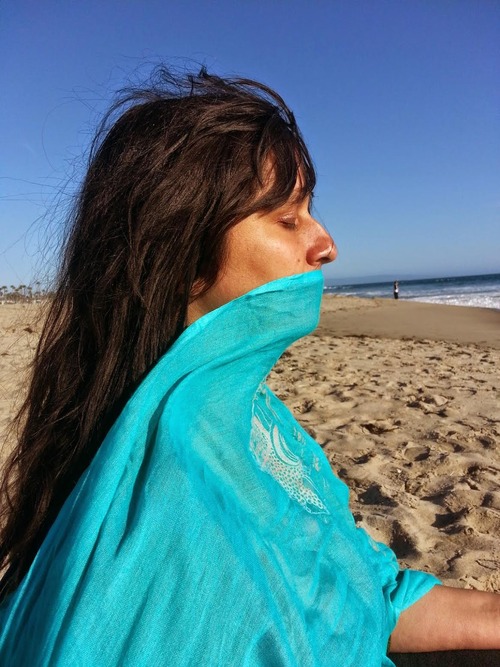
Bhanu Kapil performing from Ban en Banlieue at Venice Beach, Los Angeles, 2014.
In honor of the publication of Bhanu Kapil’s newest book Ban en Banlieue, just published by Nightboat Books, the writers Amina Cain, Douglas A. Martin, Sofia Samatar, Kate Zambreno, and Jenny Zhang gathered together in a conversation to talk about the work of the British-Punjabi writer, who teaches in the Department of Writing and Poetics at Naropa University. The conversation will be published in three parts.
Day 2: In Conversation
KATE ZAMBRENO: Bhanu Kapil is one of the most vital writers working today, and a crucial writer (and thinker) of postcolonial and displaced identity.
SOFIA SAMATAR: I don’t know what to say about why her work is important. It just makes me want to put her books into people’s hands. I do agree with Kate that Bhanu is thinking through postcolonial and migrant identity in powerful ways, and to me that has everything to do with what we’ve been saying here, about the ghostliness of her work, how much feels missing. There’s no invitation to easy discussions, no piety, no “message.” It’s very hard to essentialize the voice in these works, because it’s so fractured. And that makes it difficult to commodify the work in a way that often happens with postcolonial texts.
KZ: I think how difficult it is to commodify the texts. This integral aspect of her work and performance that is about not only refuse but also refusal.
DOUGLAS A. MARTIN: Bhanu lives in the book while she is writing it. Every day is part of the book. I suppose we all do, to some degree, but every day has the potential to seismically shift her work.
JENNY ZHANG: You know a while ago, the writer, cultural critic, and editor of The New Inquiry, Ayesha Siddiqi tweeted “why are my tweets better than your thinkpiece? bc you grew up entitled to being a ‘writer’ and I grew up being resented by white teachers” and then went on this brilliant sequence of tweets where she basically lays out what it feels like to be denied and erased and dismissed and ridiculed and disbelieved at every step of the way by the educational system when you are considered an alien in the western, industrialized world, when you are that subaltern who was supposed to fail but didn’t.
There was something so fucking powerful about Ayesha’s insistence on using a form and a forum like Twitter instead of writing that Important Thinkpiece in that Important Publication and insisting that she can do better in 140 characters than what...
You have reached your article limit
Sign up for a digital subscription and continue reading all new issues, plus our entire archives, for just $1.50/month.
Already a subscriber? Sign in




